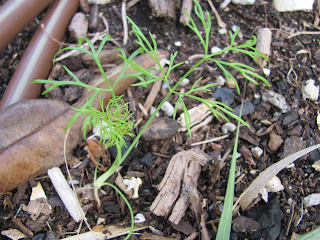Umbelliferaceae is quite a varied family of plants. Many are edible, some are violently toxic and many are ornamental. They also provide wonderful nectar and pollen for beneficial insects, that like to land on the umbels of flowers for a feed and a rest.
When they are young, it can be a bit difficult to tell which seedling is which. I happen to have a few at the moment so here are a few pictures to help.
Of course, if you can't tell, then have a little nibble.
Dill. Fine leaves, not as fine as fennel.
Dill. A slightly more dull green.
Carrot - wider than dill or fennel, pointed tips on each bit of the leaf.
Carrots. Quite pointy at the tips
Celery. Rounder ends to leaf tips than parsley. Stems are flatter too, even at this young stage.
Flat leaf/Italian parsley. Leaf tips are slightly more divied than the celery leaf.
Florence fennel/bulb fennel. See the tiny bulb developing on this seedling.
Fennel foliage. Very fine, tends to droop a little.
Coriander. More obvious leaf venation and larger surface area undivided.
Chervil. Very fine leaf and very divided. Larger gaps between the three leaflets than coriander or parsley.
























